The first European Charter for Sustainable Tourism business partners in the Baltics
In early February, the Estonian Environmental Board awarded ECST Part II certification to 10 local business partners who are working with Protected Areas to promote and deliver sustainable tourism.
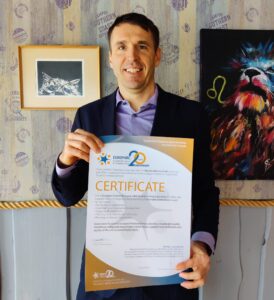
Photo credit: Nele Sõber
The first European Charter for Sustainable Tourism business partners in the Baltics
The Estonian Environmental Board, Keskkonnaamet, is a proud member of the European Charter for Sustainable Tourism (ECST). This year, they celebrated taking the next step with the ECST programme by verifying local businesses to become ECST Part II Partners. The ECST Part II are local business partners who commit to the ethos of this charter and participate in regular meetings to create and implement the sustainable tourism action plan for the Protected Area.
This awards ceremony is the first of its kind in the Baltics and is a big acheivement with 10 businesses certified. EUROPARC celebrates their commitment to continue to support the development of sustainable tourism in Matsalu, Lahemaa and Soomaa National Parks!
Sustainable tourism is Good for Parks, Good for People!
Below you can read about each of the Estonian ECST Part II partners:
Kodade Creative Centre
Business type: accommodation, event centre, tours and events
Kodade works with the Matsalu National Park on a mission to support sustainable, nature-friendly life experiences. They offer an opportunity to connect with nature, through sensory and creative activities, and with culture, through restored historical buildings and localities. Visiting Kodade and the Matsalu National Park is the ideal destination for nature and creativity enthusiasts and every year many are welcomed to take part in the creativity camps, photography training, nature hikes and boat trips and much more!
To find out more, visit their website.
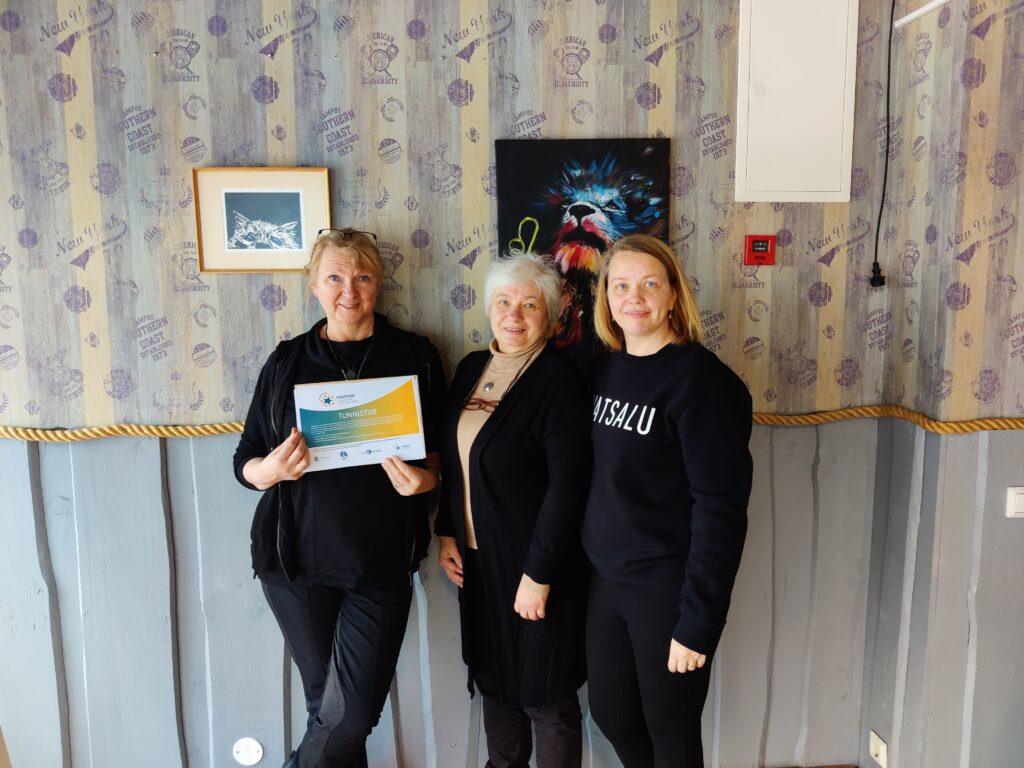
Celebrating the ECST Part II awards with partners from Matsalu National Park. Photo credit: Nele Sõber
Piesta Kuusikaru Farm
Business type: accommodation, culinary & cultural experiences
For over 150 years, the Piesta family farm has been living a life committed to the values of nature and community. The family, who have been caring for this land for many generations, want to share this rich cultural history with visitors coming to the Soomaa region and offer food tasting experiences as well as tours of the sustainable farming and crafting practices. For those looking for a travel back in time, the small riverside cottage with its traditional wood-heated sauna is available for overnight stays.
To find out more, visit their website.
Pure Water Theme Park & Ubari Center of Natural Wisdom
Business type: environmental education and excursions
Water connects us all and at the Pure Water Theme Park, where especially the young can come and learn about nature and how everything is connected. The park hosts many visitors and groups over the year, teaching them through fun outdoor learning experiences. Similarly, the Ubari Centre of Natural Wisdon is a provider of outdoor tours, experiencing nature in all its diversity for many different groups of people. Both are operated by the same company, which is committed to promoting a sustainable lifestyle by fostering a love for nature.
To find out more, visit the Pure Water Theme Park website and the Ubari Cenre of Natural Wisdom website.
Alutaguse Hiking Club
Business type: environmental education and excursions
This hiking club is committed to increasing the quality of outdoor activities by developing good relationships with partners such as the local Protected Areas and improving the environmental awareness of participants, members and customers. The hiking club has more to offer than just hiking, they also run youth camps, training courses for guides, climbing competitions and an Adventure Festival.
To find out more, visit their website.
Lahemaa Ecotourism
Business type: environmental education and excursions
Lahemaa Ecotourism has professional staff who assist local, national and international tourists have a great experience in the Lahemaa National Park and surrounding area. They are committed to providing quality service to their customers while having little to no impact on the environment and positively involving the local community.
To find out more, visit their website.
Lobi Cultural Villiage Museum
Business type: environmental education, culinary & cultural experiences
This museum is located on the Lobi Peninsula, one of the longest in Lahemaa National Park. Here, it showcases the rich cultural history of the local area, exploring themes from nature protection, to traditional livelihoods. As a business, they are committed to supporting the lifelong learning of all visitors through experiential activities, such as tasting the “Northern-Estonian local food” for which the Lobi Cultural Village Museum has a quality label. Similarly, the local staff have an inexhaustable knowledge of the regional and historical culture which they are open to sharing with visitors of all ages.
To find out more, visit their website.
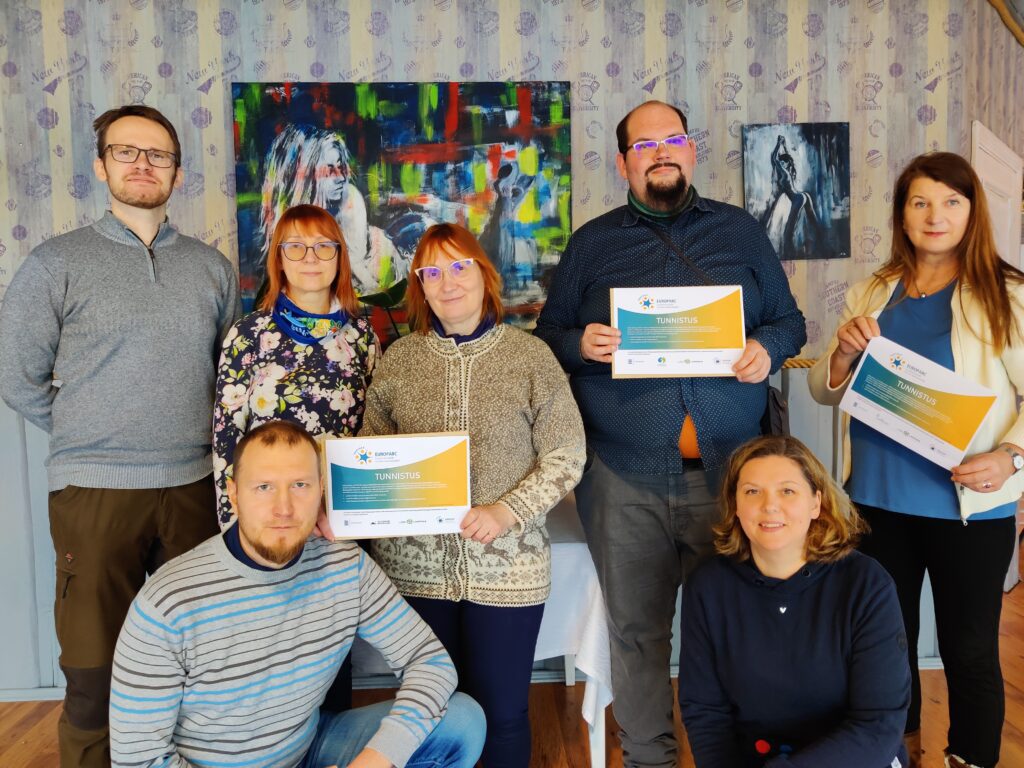
Celebrating the ECST Part II awards with partners from Lahemaa National Park. Photo credit: Nele Sõber
Tipu Nature School
Business type: environmental education & excusions
The Tipu Nature School is an NGO with a mission to connect people to nature. They run the old Tipu schoolhouse, which can be found in Soomaa National Park where they contribute by taking care of a local hiking trail, installing signs in three languages, and caring for a wooded meadow. Not only do they offer camps and outdoor activities, they also have summer volunteer placements highlighting their committment to being a place for learning, exchange and solidarity. In addition to introducing visitors to the natural and cultural heritage of Soomaa National Park region, the Tipu Nature School also strives to foster attitudes and motivation, which drives people to make informed decisions and take responsible action for nature and a sustainable future.
To find out more, visit their website.
Matka-Rebane (which means Hiking Fox)
Business type: environmental education & excusions
Matka-Rebane provides tours out in nature, introducing visitors to the nature in Soomaa across all seasons, showcasing both the natural and the cultural heritage of the landscapes and local communities. They are passionate about connecting people with nature through experiencing emotions while out in nature and using this to promote nature-friendly attitudes and behaviours.
To find out more, visit their Facebook page.
Soomaa Holiday Village
Business type: accommodation, tours and events
You can find the Soomaa Holiday Village on the banks of the Halliste River in the middle of Soomaa National Park. From here, their guests can participate in hiking, canoeing, cycling or relax in the sauna. For the small family-run business, it is important that the guests are familiar and practice ethical and sustainable outdoor behaviour and promote this through a personal approach.
To find out more, visit their website.
Soomaa.com
Business type: environmental education & excursions
This small local nature tourism company has been active in Soomaa National Park for over 25 years. Not only do they provide a plethora of guided tours in all seasons, they also promote cultural heritage through boat building workshops to promote the traditions of local dugout canoes, which were used during regular flooding (known as the 5th season). Their highly capable guides enjoy working with visitors from across the world and provide high quality nature interpretation while hiking, canoeing or snowshoeing.
To find out more, visit their website.
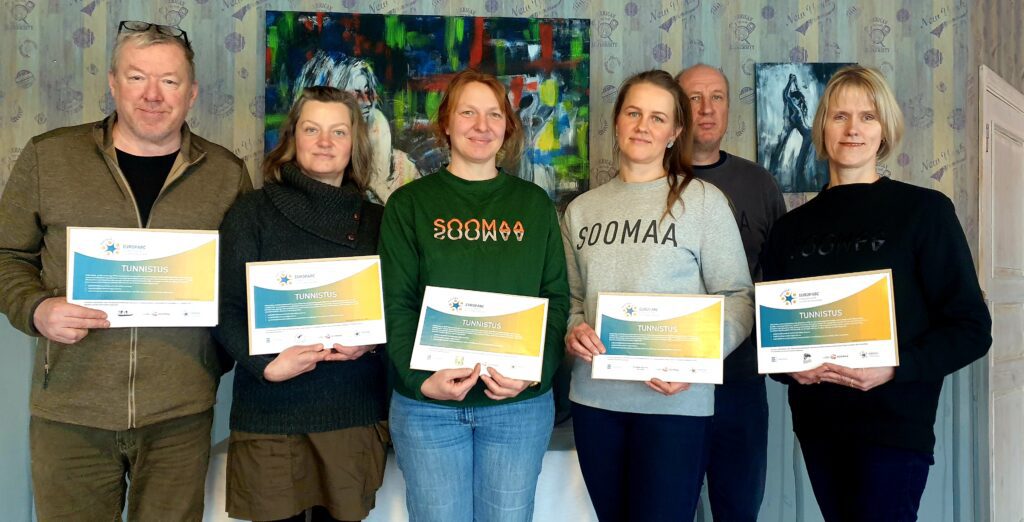
Celebrating the ECST Part II awards with partners from Soomaa National Park. Photo credit: Nele Sõber
Upcoming XII European Charter for Sustainable Tourism meeting
From the 15th to the 19th of May, tourism experts from across Europe will meet in Triglav National Park, Slovenia, to discuss, exchange and learn from each other. Interested to join them and advance your knowledge of how to implement measures for sustainable tourism and visitor monitoring?
Register Here!It’s time to utilise ethical private finance to tackle our dual crises – Statement
Workshop at the Siggen Seminar 2023
From 20 – 22nd of March, 15 participants from 12 countries came together in Gut Siggen to explore how we can upscale nature restoration through private finance during the 2023 EUROPARC Siggen Seminar.
Parks unlocked; Innovative Financing to Transform Parks across Europe.
The participants took a deep dive into models that attract private finance to unlock and drive nature restoration at scale. In particular, looking at the role Parks can play in building the market for investing in Europe’s natural capital. The time is now to take advantage of that € billion opportunity!
Together, they wrote a statement, underlying the urgency to act now, directed at the Protected Area Community, the European Commission, National and Regional parks Administrations and the Green Investment Sector:
“We, representing a cross-section of Protected Areas in Europe, have come together to unlock emerging opportunities to attract ethical private finance at scale and pace, to meet the challenges of climate change and biodiversity loss and catalyse nature restoration across Europe.
Our 15 participants from 12 countries stress the need for the Protected Area community to become “investment ready”, by creating a shared vision to turn nature restoration projects into investable business models, in order to access private finance from the ethical and green investment sector.
The need to act is now.
Together we aim to develop an innovative financing model, where private investment enhances and supplements public funds, creating social and environmental benefits with a financial return. Looking beyond our boundaries, working across biogeographical zones and utilising national and regional protected area network, we commit to collective thinking and action in order to access the billions of ethical finances available. Partnerships with the financial sector is a necessity. A clear policy and ethical framework will inform who we partner with and support the development of ambitious and high integrity nature restoration projects, in and around Protected Areas.
We will advance the development and testing of a model of innovative financing, to attract investment at scale. We want to test and develop this model to roll it out across Europe.
This process will begin with a two-year project, to map and analyse the market actors, the demand for ecosystem services, the policy environment, including carbon mechanisms and codes to support the design of high-quality natural capital projects, as well as identify pilot sites. Funding from European, national and regional administrations would help and enable your areas to Unlock not just the Parks – but the investment needed to create the resilient, healthy nature that we all need.”
The statement was signed by representatives of
EUROPARC Federation
Palladium
Comissão de Coordenação e Desenvolvimento Regional – NORTE, Portugal
Directorate General of Nature and Biodiversity. Government of Castilla-La Mancha, Spain
National Park Harz, Germany
Czech Society for Ornithology, Czech Republic
Foreste Casentinesi National Park – Italy
Triglav National Park, Slovenia
UNDP/ Sustainability of Protected Areas, Bosnia and Herzegovina
NatureScot, Scotland
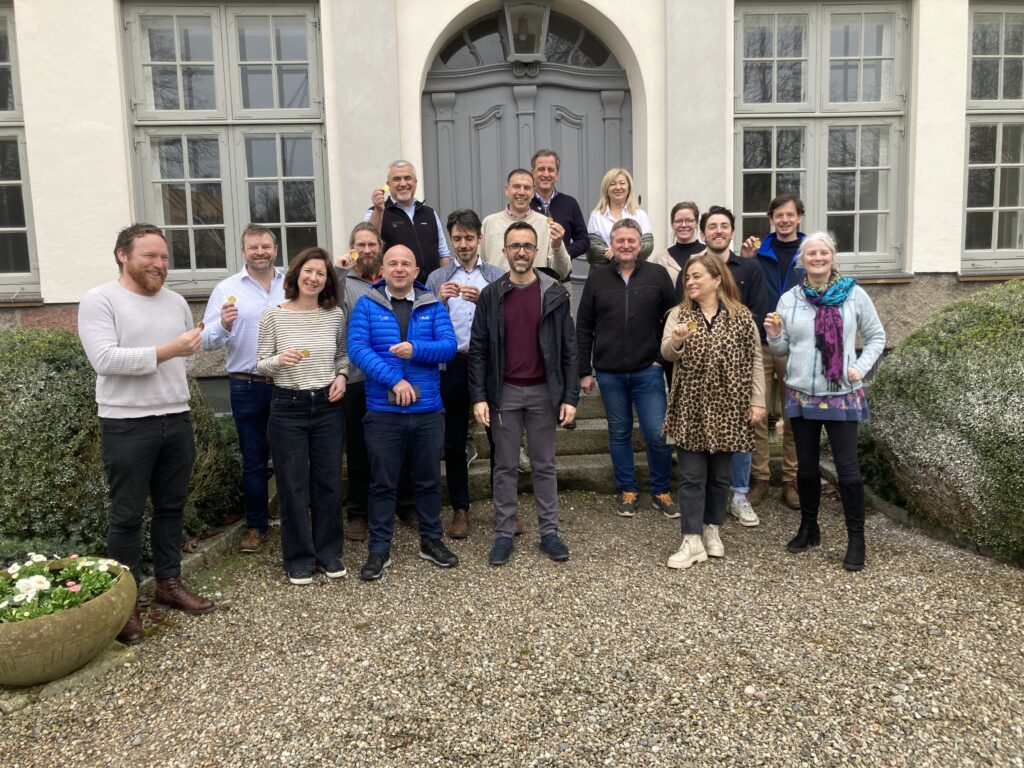
Participants of the Siggen Seminar 2023
The EUROPARC Siggen Seminar is made possible through the generous support of the Alfred Toepfer Stiftung.
We are Building on our Roots this European Day of Parks!
Every year, the European Day of Parks wants to bring People and Parks together. This year’s theme is “Building on our Roots” and we invite the EUROPARC Community to organise events on and around the 24th of May.
Building on our Roots
Our natural heritage encapsulates our identity. As such, we all have the responsibility and the joy to maintain this heritage for future generations, and discover how we can build upon it! That is why we are Building on our Roots, this European Day of Parks.
“In our heritage lies our past, present and future”
By cherishing our heritage, we are strengthening our identity and connecting ourselves to the larger, natural, environment.
This is something that we are particularly aware of at EUROPARC this year, as we are celebrating our 50th Anniversary! That is why we ask the Parks and Protected Area community to come together this year and celebrate the European Day of Parks like never before!
With almost all COVID-19 restrictions lifted in countries across Europe, we can now return to the roots of the European Day of Parks, which is getting people out into nature.
Join us!
Unsure what to do? No worries, we have created guidelines with loads of examples for activities for Parks to organise:
Share your celebration!
So, is your Protected Area ‘Building on our Roots; this European Day of Parks? Then we look forward to seeing your activities! In order for EUROPARC to showcase the amazing work you are doing, you are welcome to share any pictures or videos from your events with us:
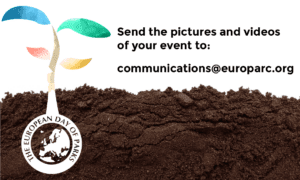
We will compile this to help promote the importance of our Protected Areas throughout Europe, and celebrate our anniversary at the EUROPARC Conference. Of course, you can also join the online conversation! Use #EuropeanDayofParks & #EDoP2023 and be sure to tag EUROPARC:
Facebook & Twitter: @EUROPARC
Instagram: EUROPARC_Federation
Linkedin: EUROPARC Federation
Of course, the banner is available in many different languages here. If you are missing your language, just send an email with the translation to the above address.
We look forward to seeing your events!
Updates in the framework of the N2000 biogeographical process – marine conservation
View of a coast of the Orkney Islands, Scotland - 20/10/2008. Photo by Laurent Chamussy
Last March 2nd, EUROPARC Federation attended the European Commission Sub-Expert Group On Marine Issues, known as Marine Expert Group – MEG, a sub-group under the Birds and Habitats Directives created in 2003 to support the implementation of the Directives in the marine environment.
The meeting was facilitated by Vedran Nikolic – Policy Coordinator, Nature Conservation, Directorate General for Environment, and attended by aprox. 75 participants and representatives from national authorities, public agencies, Marine Protected Areas management authorities, fisheries representatives and NGOs from all over Europe. The gathering aimed to provide an update on the latest developments regarding the implementation of the Biodiversity Strategy in the marine environment and the recently published Marine Action Plan.
Like in previous occasions, the Commission collected comments from the participants in relation to these documents, possible considerations on its implementation arising at national, regional or local level and tackle any other business concerning the political framework for the conservation on the marine environment and its application.
Pledges on Conservation and Protected Area targets
After the release of the Biodiversity Strategy 2030, the European Commission called to Member States to prepare and report detailed plans, known as pledges, on the actions that will be implemented for the conservation and restoration of marine habitats and species at national level by the end of February 2023.
The pledges reporting was divided into two main components:
- Pledges for Conservation Status Improvement targets and;
- Pledges for Protected Area targets.
The structure and contents of the pledges was explained during the MEG meeting, and it includes:
- Protected Areas current extent per biogeographical region/ marine region and what is expected to be achieved by 2030 – including detailed explanations on the proceeding through which new Protected Areas have been proposed or designated and the inclusion of information regarding Natura 2000 that contribute to the 10% strict protection.
- Other Area-based Conservation Measures (OECMs) current extent per biogeographical region/ marine region and what is expected to be achieved by 2030 – despite of the existing criteria set by the Convention on Biological Diversity (CBD) to design and clarify what OECMs are, these protection figures have proved to be quite controversary in previous discussions due to the uncertainties these definition and its implementation. However, in the meeting
it was highlighted that their contribution to the Biodiversity Strategy targets is very important and therefore must be included in the pledge reporting process.
- Explanation on the coherence of the network – detailed information on the criteria established for assessing the coherence of MPA networks was provided as follows:
- Representativity – ensuring that the range of marine habitats and species for which MPAs are considered appropriate are protected within MPAs;
- Replication – ensuring that enough occurrences of a given feature are protected within MPAs and ensuring replication reflects what is known about a given feature´s biogeographic range;
- Connectivity – ensuring individual MPAs are well connected in terms of facilitating the exchange of species and their propagules;
- Adequacy – ensuring individual MPAs are of a specific minimum size, especially in relation to pressure of human activities and the needs of specific habitats and species;
- Management – ensuring that effective management plans are put in place, with responsibility assigned for delivery.
Status of Pledges
A detailed revision of the reporting status of these pledges was also presented. As of March 2nd 2023, only Luxemburg and Spain have submitted their pledges on both Conservation Status and Protected Areas.
Among the remaining 25 countries, half of them is expected to be submitted in the following two months. The reasons for the delay in both pledges are mainly limited data available or capacity, length of governmental endorsement process, length of stakeholder engagement processes and obstacles in regards of the coordination between regions. All these reasons, especially the one concerning stakeholder engagement processes, were deemed by the commission as very challenging and that sufficient time should be taken to address them.
Some other difficulties found were concerning the lack of funds to carry out the necessary actions to design the necessary conservation and restoration actions and produce the pledges on time. Since the EU did not provide specific funding for the implementation of the Biodiversity Strategy, these actions should often be articulated through projects that require also time and effort from the hand of the organisations to achieve the necessary results.
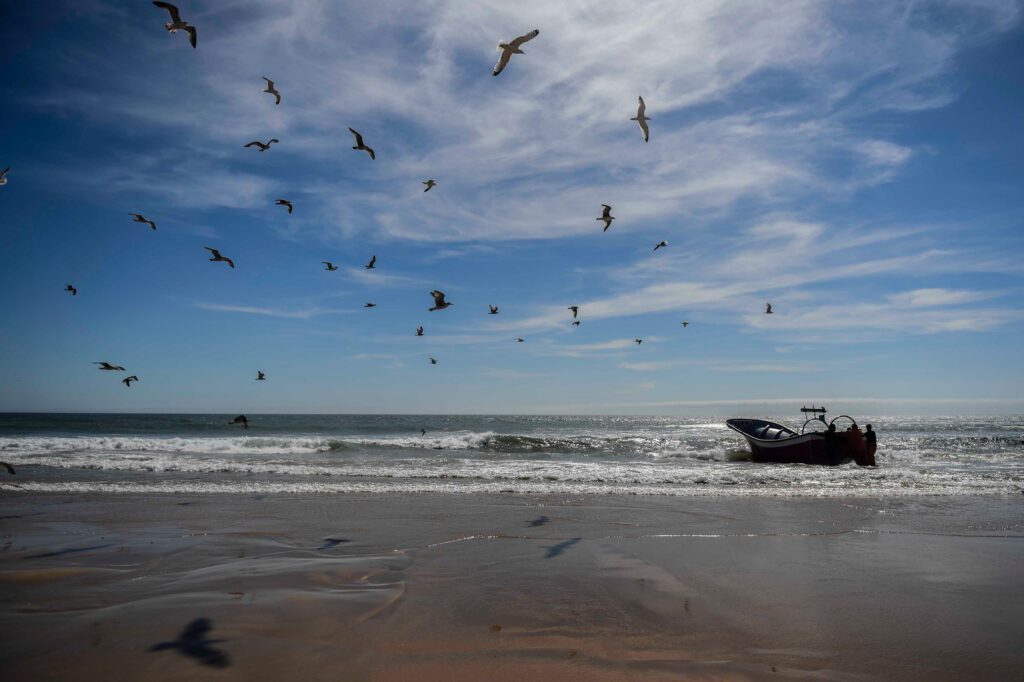
Fishermen pulling their fishing boat to the sea as seagulls fly over, Costa de Caparica, Portugal – 27/05/2019. Photo by Patricia De Melo Moreira
Pledges assessment process
After its submission, the pledges will be reviewed and assessed in order to measure progress towards the achievement of the numerical targets stated in the Biodiversity Strategy and provide initial feedback on network coherence.
The organisation in charge of receiving and managing the pledges is the European Environmental Agency, and during the meeting a representative from the EEA – Elena Osipova – presented a quick revision of the pledges assessment process and some considerations for its reporting.
On the one hand, it is noteworthy that Member States ‘commitments to the Biodiversity Strategy conservation objectives are voluntary and therefore the assessment of the pledges are not an evaluation of compliance. The aim of the assessment is to support Member States in designing and implementing their conservation strategies and to provide them with relevant topics of discussion at events and seminars organised in the framework of the biogeographical process.
On the other hand, as it was stressed during the meeting, the pledges reporting and assessment is a new process for everyone involved, and that “methodologies will develop as the picture unfolds”. Therefore, it is an open process that will be subject to revision and updates.
Additionally, the Commission reminded that the pledges assessment will be carried out during the Biogeographical Seminars that Member States are invited to organise, according to the following biogeographical regions:
- the Baltic Sea region
- Atlantic and Macaronesian regions
- Mediterranean and Black Sea regions
As of today, the call for events to be held during spring 2023 is already closed, but a second call for those events that will take place during the summer is open until April 17th. More information on the organisation of the events can be found here.
The challenges of designing coherent MPA networks
New Protected Areas will need to be designated based on smart and efficient Marine Spatial Planning in order to achieve a coherent network and based on the criteria explained above.
However, the existing species and habitats maps of Europe have proved to not to be sufficient for establishing a baseline with enough and detailed information upon which the planification of a coherent network of protected areas should be carried out. In example, some sub-habitats or habitat patches can be very important to protect but are not mapped due to their small size or distribution. Likewise, there is not enough information on habitats that sustain natural processes on which key species rely, such as reproduction and nursery areas.
For this reason, it is important to drive sufficient efforts into actions that allow us to get a better understanding of where key species, habitats and process are located in our seas in order to protected them. In this line of action, after the pledges status revision, an initiative that aims to contribute to the marine species and habitats mapping and MPAs network design was presented by Mark J. Costello – Nord University, Norway: the Horizon MPA Europe project.
This project, which will conclude in 2026, aims to carry out a wide assessment and mapping of areas that comprehend high biodiversity levels, not just species, and blue carbon storage areas in Europe, and create a model of potential MPAs. During the presentation, a model of the optimal MPA network at global scale that included 30% of the ocean, 70% of the species and 90% of biomes and habitats, was presented.
The new Marine Action Plan to conserve fisheries resources and protect marine ecosystems
The MEG meeting concluded with an overview of the recently published Action Plan: Protecting and restoring marine ecosystems for sustainable and resilient fisheries, which together with three other measures conforms the package that the European Union is putting in place to improve the sustainability and resilience of the EU’s fisheries and aquaculture sector.
This action plan builds over existing legislation and tries to fill some gaps between policies, mainly between the fisheries and environmental world, and to support the implementation of the CFP. The plan has 4 main lines of action:
- Improve gear selectivity and address bycatch of sensitive species;
- Protect the seabed;
- Facilitate knowledge exchange and transition;
- Improve Governance.
A detailed article on the Marine Action Plan can be found in our News section and more information will be available in our website – EU Marine Policies section, soon.
You can also access the whole Communication from the Commission: EU Action Plan: Protecting and restoring marine ecosystems for sustainable and resilient fisheries at the EC’s website here.